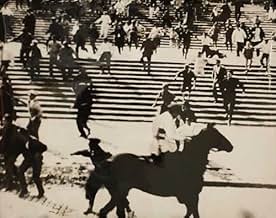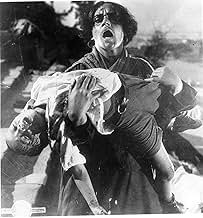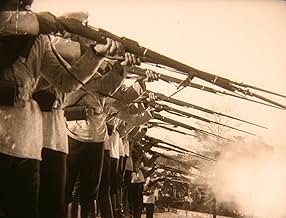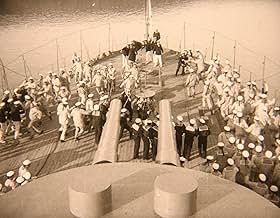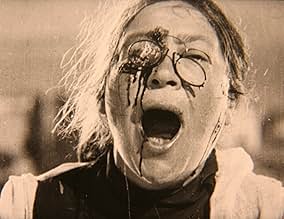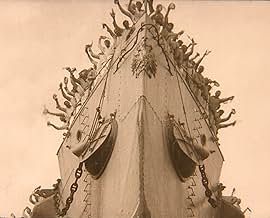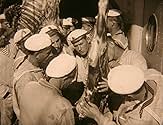IMDb RATING
7.9/10
64K
YOUR RATING
In the midst of the Russian Revolution of 1905, the crew of the battleship Potemkin mutiny against the brutal, tyrannical regime of the vessel's officers. The resulting street demonstration ... Read allIn the midst of the Russian Revolution of 1905, the crew of the battleship Potemkin mutiny against the brutal, tyrannical regime of the vessel's officers. The resulting street demonstration in Odessa brings on a police massacre.In the midst of the Russian Revolution of 1905, the crew of the battleship Potemkin mutiny against the brutal, tyrannical regime of the vessel's officers. The resulting street demonstration in Odessa brings on a police massacre.
- Awards
- 1 win total
Ivan Bobrov
- Young Sailor Flogged While Sleeping
- (as I. Bobrov)
Nina Poltavtseva
- Woman With Pince-nez
- (as N. Poltavtseva)
Iona Biy-Brodskiy
- Student
- (as Brodsky)
Sergei Eisenstein
- Odessa Citizen
- (as Sergei M. Eisenstein)
Andrey Fayt
- Recruit
- (as A. Fait)
Summary
Reviewers say 'Battleship Potemkin' is acclaimed for its pioneering montage and editing, significantly impacting cinema. The 1905 Russian Revolution portrayal, especially the Odessa Steps scene, is lauded for its potent visuals and emotional resonance. Many praise its technical innovations and contribution to filmmaking. However, some criticize its political propaganda and shallow character development. Nonetheless, 'Battleship Potemkin' is widely recognized as a cinematic masterpiece and a vital historical film.
Featured reviews
An epic of the Russian revolution, Battleship Potemkin, perhaps not so correctly historically, addresses the Russian revolution of 1905. With memorable scenes, especially the flag and the staircase scenes, Russian cinema is perhaps not so shy about showing violence. Which ends up enhancing and giving a more shocking experience when watching the film. A great movie considering the time it was released.
This classic is filled with vivid images that stay in your mind after you have watched it, and there is a lot to appreciate in the way that the key scenes were set up and photographed. The visuals are so impressive that the movie's imperfections are usually not so noticeable, and they don't keep it from being a memorable film.
The movie certainly deserves the praise that it gets both for the influence that it has had, and for some ideas that for the time were most creative. The famed 'Odessa Steps' sequence alone demonstrates both fine technical skill and a keen awareness of how to drive home an image to an audience. It deserves to be one of cinema's best remembered sequences. Some of the other scenes also demonstrate, to a lesser degree, the same kind of skill.
It says a lot for how effective all of the visuals are that so many viewers think so highly of "Battleship Potemkin" despite a story that is sometimes heavy-handed, and despite characters and acting that are both rather thin. These features might simply stem from the collectivist philosophy that lies behind the story, and they are obscured most of the time by Eisenstein's unsurpassed ability to present pictures that viewers will not forget.
Despite the flaws, this is a movie that most fans of silent films, and anyone interested in the history of movies, will want to see. There's nothing else in its era that's quite like it.
The movie certainly deserves the praise that it gets both for the influence that it has had, and for some ideas that for the time were most creative. The famed 'Odessa Steps' sequence alone demonstrates both fine technical skill and a keen awareness of how to drive home an image to an audience. It deserves to be one of cinema's best remembered sequences. Some of the other scenes also demonstrate, to a lesser degree, the same kind of skill.
It says a lot for how effective all of the visuals are that so many viewers think so highly of "Battleship Potemkin" despite a story that is sometimes heavy-handed, and despite characters and acting that are both rather thin. These features might simply stem from the collectivist philosophy that lies behind the story, and they are obscured most of the time by Eisenstein's unsurpassed ability to present pictures that viewers will not forget.
Despite the flaws, this is a movie that most fans of silent films, and anyone interested in the history of movies, will want to see. There's nothing else in its era that's quite like it.
If you're a film student, or were one, or are thinking of becoming one, the name Battleship Potemkin has or will have a resonance. Sergei Eistenstein, like other silent-film pioneers like Griffith (although Eisenstein's innovations are not as commonplace as Griffith's) and Murnau, has had such an impact on the history of cinema it's of course taken for granted. The reason I bring up the film student part is because at some point, whether you'd like it or not, your film professor 9 times out of 10 will show the "Odessa Stairs" sequence of this film. It's hard to say if it's even the 'best' part of the film's several sequences dealing with the (at the time current) times of the Russian revolution. But it does leave the most impact, and it can be seen in many films showcasing suspense, or just plain montage (The Untouchables' climax comes to mind).
Montage, which was not just Eistenstein's knack but also his life's blood early in his career, is often misused in the present cinema, or if not misused then in an improper context for the story. Sometimes montage is used now as just another device to get from point A to point B. Montage was something else for Eisenstein; he was trying to communicate in the most direct way that he could the urgency, the passion(s), and the ultimate tragedies that were in the Russian people at the time and place. Even if one doesn't see all of Eisenstein's narrative or traditional 'story' ideas to have much grounding (Kubrick has said this), one can't deny the power of seeing the ships arriving at the harbor, the people on the stairs, and the soldiers coming at them every which way with guns. Some may find it hard to believe this was done in the 20's; it has that power like the Passion of Joan of Arc to over-pass its time and remain in importance if only in terms of technique and emotion.
Of course, one could go on for books (which have been written hundreds of times over, not the least of which by Eisenstein himself). On the film in and of itself, Battleship Potemkin is really more like a dramatized newsreel than a specific story in a movie. The first segment is also one of the great sequences in film, as a mutiny is plotted against the Captain and other head-ups of a certain Ship. This is detailed almost in a manipulative way, but somehow extremely effective; montage is used here as well, but in spurts of energy that capture the eye. Other times Eisenstein is more content to just let the images speak for themselves, as the soldiers grow weary without food and water. He isn't one of those directors who will try to get all sides to the story; he is, of course, very much early 20th century Russian, but he is nothing else but honest with how he sees his themes and style, and that is what wins over in the end.
Some may want to check it outside of film-school, as the 'Stairs' sequence is like one of those landmarks of severe tragedy on film, displaying the ugly side of revolution. Eisenstein may not be one of the more 'accessible' silent-film directors, but if montage, detail in the frame, non-actors, and Bolshevik themes are your cup of tea, it's truly one of the must sees of a lifetime.
Montage, which was not just Eistenstein's knack but also his life's blood early in his career, is often misused in the present cinema, or if not misused then in an improper context for the story. Sometimes montage is used now as just another device to get from point A to point B. Montage was something else for Eisenstein; he was trying to communicate in the most direct way that he could the urgency, the passion(s), and the ultimate tragedies that were in the Russian people at the time and place. Even if one doesn't see all of Eisenstein's narrative or traditional 'story' ideas to have much grounding (Kubrick has said this), one can't deny the power of seeing the ships arriving at the harbor, the people on the stairs, and the soldiers coming at them every which way with guns. Some may find it hard to believe this was done in the 20's; it has that power like the Passion of Joan of Arc to over-pass its time and remain in importance if only in terms of technique and emotion.
Of course, one could go on for books (which have been written hundreds of times over, not the least of which by Eisenstein himself). On the film in and of itself, Battleship Potemkin is really more like a dramatized newsreel than a specific story in a movie. The first segment is also one of the great sequences in film, as a mutiny is plotted against the Captain and other head-ups of a certain Ship. This is detailed almost in a manipulative way, but somehow extremely effective; montage is used here as well, but in spurts of energy that capture the eye. Other times Eisenstein is more content to just let the images speak for themselves, as the soldiers grow weary without food and water. He isn't one of those directors who will try to get all sides to the story; he is, of course, very much early 20th century Russian, but he is nothing else but honest with how he sees his themes and style, and that is what wins over in the end.
Some may want to check it outside of film-school, as the 'Stairs' sequence is like one of those landmarks of severe tragedy on film, displaying the ugly side of revolution. Eisenstein may not be one of the more 'accessible' silent-film directors, but if montage, detail in the frame, non-actors, and Bolshevik themes are your cup of tea, it's truly one of the must sees of a lifetime.
Sergei Eisenstein's silent masterpiece is a very influential and possibly the most famous landmark film ever made. Many, many memorable scenes, including one of the best and most powerful scenes in film history, the massacre on the Odessa steps. No film in our time has captured such power and amazement from one sequence. Along from being a landmark in film history, it also has a strong message on brotherhood and power hungry leaders. This one has stood the test of time and will for ever more.
A milestone in cinematic history, 'Bronenosets Potyomkin' is one of the handful of great films out there that richly deserves to be called a classic. It was the picture that made Sergei M. Eisenstein a figurehead of film-making at the time. And today, it is still remembered as the wonderful piece of cinema it always has been.
'Potyomkin' is a film that NEEDS to be seen as one entity, not to be picked at. Don't just watch those clip shows where they only present the 'Odessa steps' sequence and then move on to 'Citizen Kane' or 'The Godfather', see it all in it's glorious 75-minute running time to really understand and enjoy it. Don't expect every infinitesimal detail to be perfect though, I mean the acting of the '20s silent era makes 'Scooby Doo' look like a master of understated realism, certain plot points may seem illogical and some of the battle sequences look dated, but it is still an immensely enjoyable movie.
The most memorable moments in the film are the mutiny on the battleship, Vakulinchuk's body falling off the ship, the sailor under the tent at the end of the pier, the mother holding her dead child, the baby carriage on the Odessa steps and the lion rising up to roar as further carnage ensues. For each new pair of eyes that look upon it, 'The Battleship Potemkin' comes alive once again.
'Potyomkin' is a film that NEEDS to be seen as one entity, not to be picked at. Don't just watch those clip shows where they only present the 'Odessa steps' sequence and then move on to 'Citizen Kane' or 'The Godfather', see it all in it's glorious 75-minute running time to really understand and enjoy it. Don't expect every infinitesimal detail to be perfect though, I mean the acting of the '20s silent era makes 'Scooby Doo' look like a master of understated realism, certain plot points may seem illogical and some of the battle sequences look dated, but it is still an immensely enjoyable movie.
The most memorable moments in the film are the mutiny on the battleship, Vakulinchuk's body falling off the ship, the sailor under the tent at the end of the pier, the mother holding her dead child, the baby carriage on the Odessa steps and the lion rising up to roar as further carnage ensues. For each new pair of eyes that look upon it, 'The Battleship Potemkin' comes alive once again.
Did you know
- TriviaThe film censorship boards of several countries felt this movie would spread communism. France imposed a ban after a brief run in 1925; it lifted it in 1953 after the death of Russian leader Joseph Stalin. The UK banned it until 1954.
- GoofsIn the Imperial squadron near the end of the film, there are close-ups of triple gun turrets of Gangut-class dreadnought. It possibly was made this way to show the power of Imperial fleet, but battleships of 1905 were much smaller pre-dreadnoughts, with twin turrets only, just like "Potemkin". "Ganguts" entered service in 1914.
- Alternate versionsSergei Eisenstein's premiere version opened with an unattributed quote from Leon Trotsky's "1905": The spirit of mutiny swept the land. A tremendous, mysterious process was taking place in countless hearts: the individual personality became dissolved in the mass, and the mass itself became dissolved in the revolutionary impetus. This quote was removed by Soviet censors in 1934, and replaced by a quotation from V.I. Lenin's "Revolutionary Days": Revolution is war. Of all the wars known in history, it is the only lawful, rightful, just and truly great war...In Russia this war has been declared and won. The original text was restored in 2004.
- ConnectionsEdited into Seeds of Freedom (1943)
- How long is Battleship Potemkin?Powered by Alexa
Details
- Release date
- Country of origin
- Languages
- Also known as
- Battleship Potemkin
- Filming locations
- Sevastopol, Crimea, Ukraine(battleship scenes)
- Production company
- See more company credits at IMDbPro
Box office
- Gross US & Canada
- $51,198
- Opening weekend US & Canada
- $5,641
- Jan 16, 2011
- Gross worldwide
- $62,723
- Runtime1 hour 15 minutes
- Color
- Sound mix
- Aspect ratio
- 1.33 : 1
Contribute to this page
Suggest an edit or add missing content


